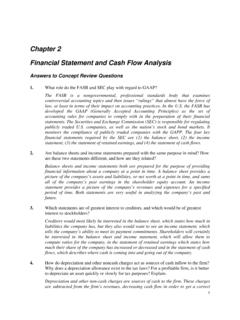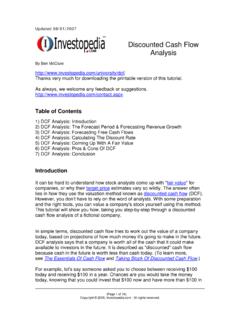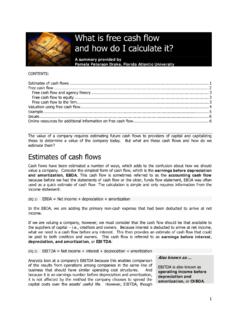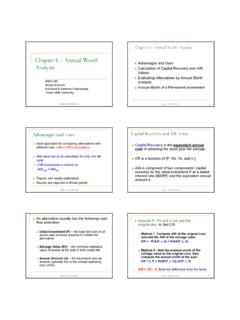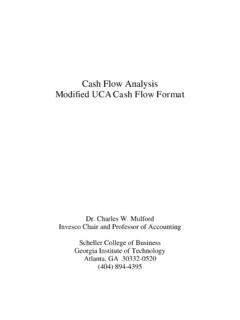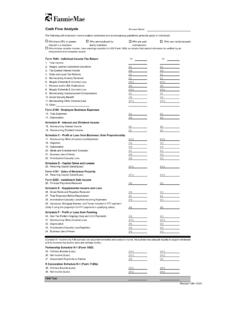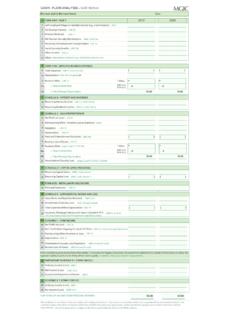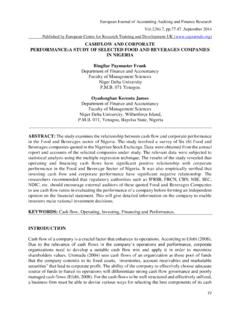Transcription of COMMERCIAL REAL ESTATE: APPRAISALS & CASH FLOW …
1 COMMERCIAL REAL ESTATE: APPRAISALS & cash flow ANALYSIS Richard A. Hamm President & Owner Advantage Consulting & Training Huntsville, AL 256-503-5591 August 2-4, 2018 1 CRE cash flow and AppraisalsAugust 2018 Richard HammAdvantage Consulting & Distinguish between CRE and C&I loans Properly develop cash flow of an income-producing property and use it to derive debt service coverage (DSC), value estimate and loan-to-value (LTV Conduct/evaluate stress-testing of a project at the transaction level Identify key inputs and factors that influence capitalization ( cap ))
2 Rates Identify key appraisal issues and regulations Appendix: Identify non-financial CRE lending risksTerminology: C&I and CRE Loans COMMERCIAL & industrial loans (C&I) generally do not involve RE Various call reports and most loan coding systems: If any RE collateral, then RE loan Business loans where operating cash flow is PSOR but RE is collateral should be effectively considered C&I _____ usually is applied to C&I loans secured by RE such as manufacturing plants, warehouses, offices, retail stores, etcTerminology: C&I and CRE Loans (cont.)
3 True CRE loan depends on rental income or planned RE sales as the primary source of repayment (PSOR) _____ usually describes income-producing, investment or other true CRE loans Liquidation (by bank, unplanned) is SSOR for both3 Terminology: OO and NOO Loans With OO loans, most of land and improvements (50%+) will be utilized by owner Directly via same entity Indirectly via entity with substantiallycommon ownership Usage test can be based on Space occupied Rental incomeSimilarities and Differences in COMMERCIAL LoansBusiness financial statements and/or tax returnsMonitoring/ ReportingPrimarily fixed, some floatingPrimarily floating, some fixedInterest RatesLong-term (amortization 15-20 yrs.)
4 , maturity 3-5 yrs.)Short-term (AR+INV) Medium-term (EQ)Structure/ AmortizationRE + FixturesNon-RE (AR, INV, EQ)CollateralLiquidation of RE CollateralLiquidation of non-RE collateralSSORCash flow from operationsPSORNOO REOO REC&IDeveloping Property NOI & CFADS CRE cash flow measures: NOI (net operating income) and CFADS ( cash flow available for debt service) Old-fashioned net income + depreciation (a non-cash expense) + interest expense (to avoid double-counting with interest as part of debt service) for historical NOI Start with earnings before interest, taxes and depreciation and amortization (EBITDA) Then adjust for capitalized expenditures to get historical NOI Then adjust expenses (some smoothed, some imputed)
5 To get pro-forma or projected NOI More adjustments, primarily for distributions or unusual income or expenses, to get CFADS, historical and pro-forma Ignores most business balance sheet sources and uses of cash (direct method cash flow used for C&I businesses), because Land/building likely only significant asset Loan/mortgage likely only significant liabilityUnderwriting Variables Basic steps to NOI (bankers and appraisers) and CFADS (bankers)1. Develop gross potential income or gross rents, historical and pro-forma Not provided by tax returns Need rent roll or property configuration # units x rental rate per month x 12 months Awareness of unusual lease terms Events of default by landlord Events of default by tenant Cotenancy clauses, Variables (cont.)
6 2. Develop _____ vacancy Also not provided by tax returns Start with gross potential income developed above Then subtract your gross rents or rents received from top line of tax return Example blank Form 8825 on page 15 Underwriting Variables (cont.) When using tax returns, bankers work backwards to determine historical vacancy Rents Received on Schedule E Gross Rents on 8825 Gross Effective Income Less: VacancyGross Potential IncomeTax Return Data(Schedule E or Form 8825)Customer Data andBank NOI WorksheetUnderwriting Variables (cont.)
7 3. Develop _____ vacancy Three factors to consider1. _____ levels and trend of the property (non-construction and where data available)2. _____ levels and trends/conditions3. _____ minimums/guidelines Blindly sticking with historical levels and/or policy guidelines are traps to avoid _____ occurs when occupancy of subject property reaches market levels (100% market vacancy)Underwriting Variables (cont.) Keep in mind, there are two types of vacancy1. _____ (unit is empty)2. _____ Late or no payment Check bounces (credit or collection loss) Rent concessions or give-aways Appraisers use phrase vacancy and credit loss 7 Differentiated Underwriting Guidelines Example Grid15%10%5%Min Vacancy Factor24 months24 months36 monthsMax Construction Term85%85%85%Max FDICIA LTV20 years20 years30 yearsMax Amortization5 years5 years5 yearsMax Loan Pre-Leasing/Pre-sales DSC20% (10%)25% (15%)15% (5%)Min Equity (Cash)
8 80%80%85%Max LTC75%75%80%Max LTVM ulti-Tenant Office BuildingUnanchored Shopping CenterApts >100 Units** Example Only **Underwriting Variables (cont.)4. Impute pro-forma management fee Usually at 4-6% (use going rate in property s market) of net rentsin pro-forma, even if no actual fees paid in historical data NOT to simulate costs if foreclosure occurs Banker is not making a liquidation analysis Recognizes that a large portion of purchasers will not self-manage Exception: residential rental properties where self-management is prevalentUnderwriting Variables (cont.)
9 5. Historical maintenance and repair costs Most costs will be expensed in current year and shown on Schedule E or Form 8825 Tax and accounting rules may require some costs to be capitalized onto balance sheet, then depreciated or amortized over several years If improvement extends useful life of property, it should be capitalized This is very subjective, however, leaving room to fully expense cost in year made, especially if customer wants to defer taxable incomeUnderwriting Variables (cont.)6. Create pro-forma _____ Sometimes called reserves for replacement Usually impute in pro-forma column at 2-3% of gross potential income, with 5% often more appropriate in medium to smaller properties Pro-forma amount may be higher due to property age, historical trends or observed need for deferred maintenance Historical costs tend to fluctuate greatly, so pro-forma in an estimate of expected, average, ongoing annual expenditures over time9 Underwriting Variables (cont.)
10 6. Create pro-forma maintenance reserve (cont.) Assessed even in first years of new properties Sets aside cash flow annually for big ticket repairs down the road Usually not funded or escrowed, unless required by Lender due to significant deferred maintenance Government programs, such as state affordable housingUnderwriting Variables (cont.) Deferred maintenance May be assessed as a one time expense May create material cash flow change from year to year, requiring multi-column NOI analysis or discounted cash flow (DCF) Obvious improvements needed to render property lease-able (in purchase or renovation situation) New paint or carpeting Integrity of roof (leaks) Potholes in parking lotUnderwriting Variables (cont.)
